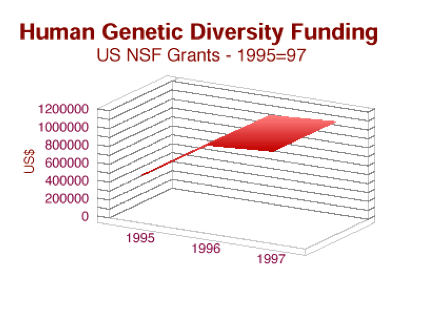Enviado por ETC Staff el

The US National Science Foundation continued to fund the Human Genome Diversity Project (HGDP) even as the NSF awaited a report it itself commissioned in order to determine if the HGDP met peer-approved scientific and ethical standards. Following an exhaustive 30-month investigation, the report, tabled by a blue-ribbon committee of the National Research Council, advised against the HGDP proposal citing both ethical and scientific shortcomings.
Total support from the NSF's Physical Anthropology Program for human biodiversity activities nearly doubled between 1995 and 1997. Between the time the NSF commissioned the HGDP evaluation in mid-1995 and the time the NRC committee tendered its report rejecting the HGDP as a viable project, on October 21st this year, the NSF disbursed $2,197,832 in 21 grants related to human genetic diversity research and/or collection. Of that, $1,143,748 (or 52%) went to 10 HGDP activities. The most recent HGDP allocations were made only a few weeks before the NRC's negative findings were made public. Some grants went to the HGDP to address questions which had already been assigned to the evaluation committee.
While the grants made explicitly to the HGDP were for studies clearly intended to pave the way for the Project's proposed international blood collection work, many of the other grants were to HGDP-associated researchers for the investigation of specific indigenous populations.
Among the grants approved were: work in Tibet on a gene found among peoples living above 4000 metres that facilitates oxygen absorption in the bloodstream and also appears to improve their reproductive fitness"; an investigation of the genetic diversity of insular Southeast Asians with the peoples of New Guinea and Polynesia; susceptibility to diabetes and resistance to cancer among Plains Apache in Oklahoma (USA); a study of the genetic evolution of four South India caste populations as well as two "tribal" populations; measurement of the basal metabolic rate and cold-tolerance of Mongolia's pastoral nomads; research based on 800 individuals sampled from New Guinea to the furthest reaches of Melanesia; sampling and stress study of 70 individuals from two locations in Botswana; study of rural Quechua in Norte de Potosi, Bolivia; genetic investigation of eight groups in La Paz and Santa Cruz, Bolivia; analysis of aboriginal populations of Australia and New Guinea; comparison of exhumed remains of 47 ancient Native Americans from Stillwater Marsh and Pyramid Lake, Nevada with indigenous peoples in the Western US today; and, blood sampling of youth among six villages in Western Samoa.
| Adjunto | Tamaño |
|---|---|
| 0 bytes |
